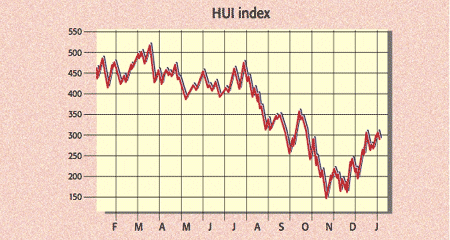
What could you have bought on 1 January 2008, and still have your wealth intact come 1 January 2009? Gold, says Peter Grandich of The Grandich Letter. Trading around $860 an ounce, the gold price is right where it was this time last year, which isn’t something that can be said for many assets. And it looks like you should cling to your gold in 2009 too. Demand for the yellow metal hit a record high in the third quarter, says the World Gold Council, while supply dropped by 9.7%. Even though the recession will probably lead to slackening demand for jewellery (Indian imports have already dropped for a second month in December), there are two reasons to remain bullish. Firstly there’s gold’s traditional status as a safe haven. For example, in August last year, as concerns about the financial system mounted, sales of the gold American Eagle coin were suspended for a week because the US Mint couldn’t source enough blank gold coins from suppliers to satisfy demand.
Secondly, the stimulus packages being mounted by the Fed and governments around the world have the potential to bring back inflation sooner or later, with the result that precious metals will strengthen “against all paper currencies and other assets”, says Marc Faber of the Gloom, Boom and Doom report. “Weak supply, strong demand and valid fears of inflation are a perfect mix of ingredients for a gold rally,” adds Martin Hutchinson on Breakingviews. How high could it rise? Standard Chartered Bank forecasts gold will average $985 an ounce in 2009, up from an earlier forecast of $875. But it could have much further to go. The previous high set in January 1980 was $875 – if you adjust for inflation, that’s $2,430 in today’s money.
You can get exposure to gold through London-listed exchange-traded funds, such as the ETFS Physical Gold (LSE:PHAU). More profitable for those with a bigger risk appetite might be to invest in gold stocks. Following “devastating declines, some gold-mining exploration companies should also offer substantial upside potential”, says Faber. The Amex Gold BUGS Index (US:HUI), which tracks the performance of major gold stocks, is down 32% in the past year (see chart), meaning gold producers are trading at a big discount to the gold price. One way to take advantage is through BlackRock Gold & General fund, which invests in precious metal miners. Managed by Graham Birch since 1999, it’s up 84% over five years but down 15.7% over the past year.